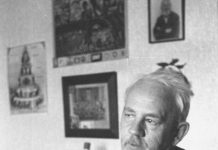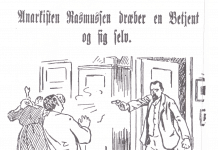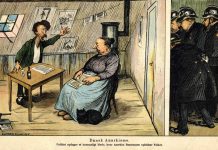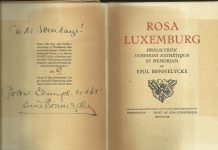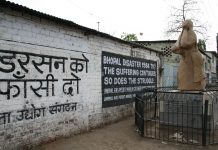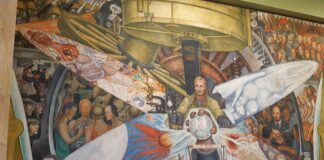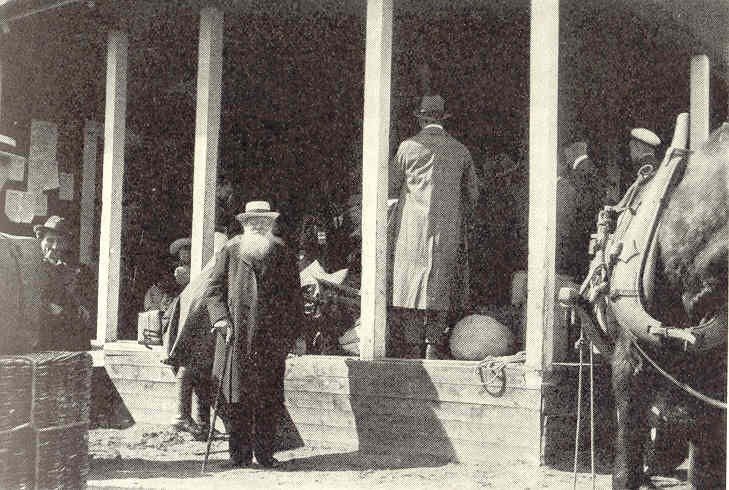
Socialistisk Biblioteks Tidslinje med links til begivenheder og personer i 1921.
Se også Index over personer, organisationer/partier og værker (som bøger, malerier, mm.), steder, begivenheder, mv., der er omtalt på hele Tidslinjen, titler og indhold på emnelisterne osv.
Bladliste
Nye blade 1921:
Arbejderbladet. Dagblad. Fra 3. februar 1922 stod DKP som udgiver.
Baalet. Tidsskrift for Liv og Kunst. Udgivet af ”Litterær Arbejder-klub”.
Daggry. Fortsættelse af Arbejdertidende, se 1919.
Samarbejdet. Organ for den uafhængige fagbevægelse. Ugeblad. Udg. af De frie fagforeninger. Syndikalister uden for parti/DKP-samarbejdet.
Se:
- Arbejderhistorisk bladliste, under året 1921, og se 20. maj nedenfor.
8. februar 1921
Den russiske anarkist Peter (Pjotr) Kropotkin dør i Dmitrov, 65 km nord for Moskva (født 21. december 1842 i Moskva).
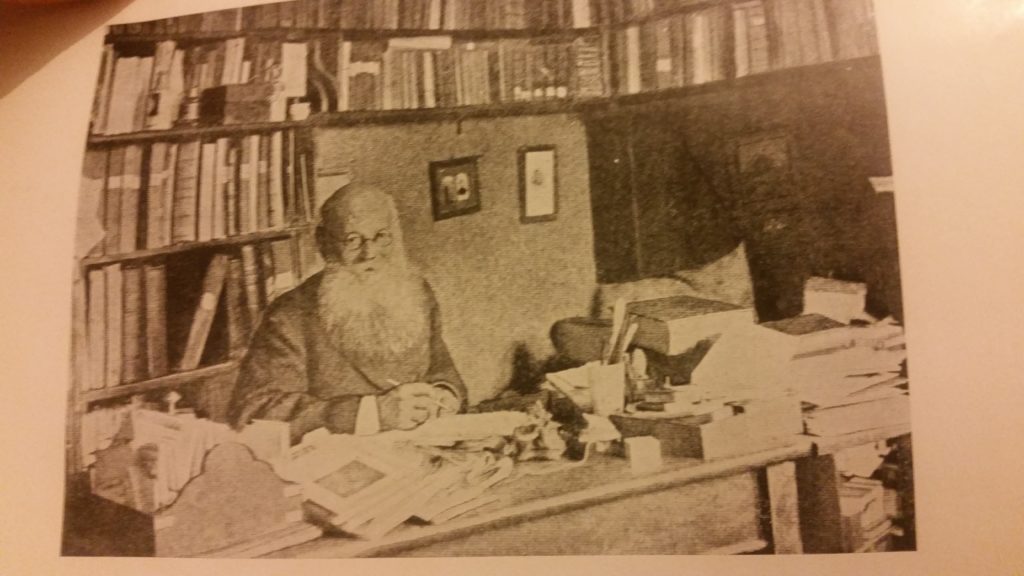
Piotr Kropotkin at his desk, circa 1890. Photo: Unknown. Public Domain. Source: Wikimedia Commons.
Se:
- Kropotkin, Pjotr (Leksikon.org)
- Kropotkin, Pjotr (Foreningen Sorte Fane). Oversigt over tekster på dansk + links.
- Peter Kropotkin (Anarchy Archives: An Online Research Center on the History and Theory of Anarchism)
- Peter Kropotkin (Marxists Internet Archive; Reference Archive)
Se også på Socialistisk Bibliotek:
- Personlisten: Peter Kropotkin (1842-1921)
- Emnelisten: Anarkisme vs. Marxisme / Anarchism vs. Marxism
2. marts 1921
Kronstadt-oprøret startes af soldater og matroser som reaktion på Bolsjevikpartiets politik over for landbruget og på situationen i landet. Opstanden slås ned 17. marts.
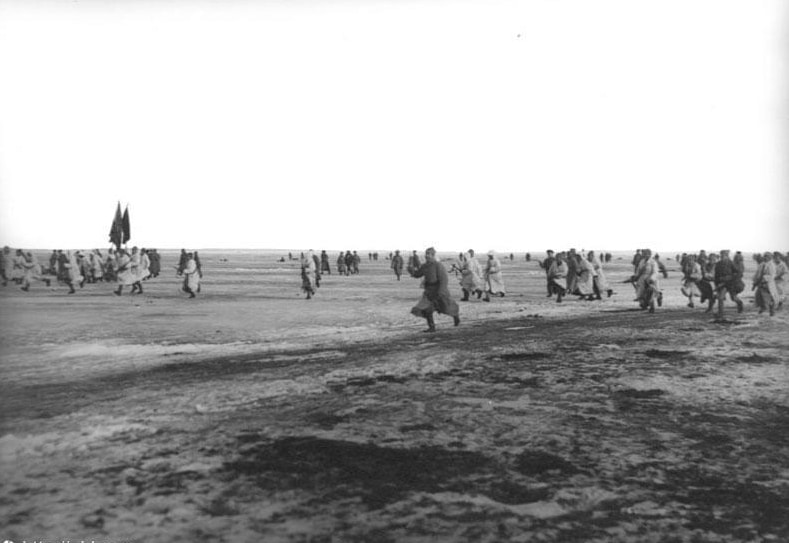
Se:
- Kronsjtadt (Leksikon.org)
- Kronstadt rebellion (Wikipedia.org)
Se også på Socialistisk Bibliotek:
- Linkboxen: Kronstadt 1921
8.-16. marts 1921
SUKP’s (Bolsjevikkerne) 10. kongres vedtager ny økonomisk politik (NEP) og fagforeningsresolution.
Se:
- NEP (Leksikon.org)
- Resolutions of Soviet Party Congresses (Marxists Internet Archive; Soviet History Archive). Scroll ned.
1921 turning point? (Weekly Worker, Issue 1338, 11 March 2021). “Mike Macnair spoke to Online Communist Forum on March 7 about the related centenaries of the 1921 Kronstadt rebellion, the adoption of the NEP and the ban on factions in the Russian Communist Party.”
A barometer of progress (Weekly Worker, Issue 1293, April 2, 2020). “NEP had profoundly negative results for the struggle for women’s emancipation.”
What the New Economic Policy did — and what it left unfinished. By Samuel Farber (Jacobin, 29 December 2019). “The NEP helped the young Soviet Union rebound economically. But its lack of political reform hampered the ability of workers and peasants to resist the onset of Stalinism.”
The New Economic Policy was the alternative to Stalinism. By John Marot (Jacobin, 8 December 2019). “Generations of left-wing thinkers have fundamentally misunderstood the young Soviet Union’s New Economic Policy.”
Perestroika’s revival of NEP: a contemporary chronicle, 1985-1990 (pdf). By Lars T. Lih (The NEP Era: Soviet Russia 1921-1928, Vol.3, 2009, p.1-35). “The NEP theme proved to be an extremely rich guide to the debates swirling in the Soviet media that were such a hallmark of the Gorbachev years.”
See also Lars T. Lih: Political testament of Lenin and Bukharin and the meaning of NEP (Slavic Review, Vol.50, No.2, Summer, 1991, p.241-252; online på LibCom).
The crisis of 1921: The beginnings of the N.E.P. and the rise of the apparatus. Chapter 7 in Pierre Broué: The history of the Bolshevik Party (CP) of the USSR: The political struggles in Russia (1921–1929) (1971, online at Marxists Internet Archive)
The political struggles in Russia, 1921-1929. By Pierre Broué (Marxists Internet Archive). Chapter 7-11 of The history of the Bolshevik Party (CP) of the U.S.S.R. (1971; online at Marxists Internet Archive)
Se også:
1921 turning point? (Weekly Worker, Issue 1338, 11 March 2021). “Mike Macnair spoke … about the related centenaries of the 1921 Kronstadt rebellion, the adoption of the NEP and the ban on factions in the Russian Communist Party.”
The Red Jacobins: Thermidor and the Russian Revolution in 1921 (pdf) (Permanent Revolution, Issue 17, Summer 2010, p.30-45). “Mark Hoskisson argues that the anti-Stalinist left has underestimated the significance of 1921 in sealing the fate of the revolution.”
17. marts 1921
Starter “Marts-aktionen”, da Tysklands kommunistparti (KPD) over for sikkerhedspolitiets overgreb mod minearbejderne i Centraltyskland opfordrer til bevæbnet opstand og senere til generalstrejke, imod flertallet af arbejderne, i tro på, at den revolutionære situation kan skabes gennem offensiv af de revolutionære selv.
“Offensiv-teorien” kostede KPD, der lige var blevet et masseparti med ca. 500.000 medlemmer, omkring halvdelen af medlemmerne. formanden Paul Levy
Links:
March Action (Wikipedia.org)
The March Action and the Tragedy of German Communism. By Paul Frölich.
“A hundred years ago today, the German Communists tried to spark a revolution, but their would-be uprising ended in disaster. In this extract from a recently discovered memoir, Rosa Luxemburg’s biographer Paul Frölich describes the failure of the 1921 March Action and its impact.”
Martsaktionen 1921. Kap. 6 i Charlie Lywood: Den tabte revolution: Tyskland 1918-23 (Internationale Socialisters Forlag, 1997, side 35-40).
Se på Socialistisk Bibliotek:
Tidslinjen 11. marts 1883 om Paul Levi, KPD’s formand, der er central i debatten om aktionen og dens konsekvenser.
Linkboxen: Den tyske revolution 1918-23, med afsnit om “Marts-aktionen”.
6. maj 1921
Tyendeloven (“Slaveloven”) med husbonds revselsesret og tyendes pligt til den forhadte skudsmålsbog, hvis man ville arbejde udensogns, afløses af Medhjælperloven.
Loven blev indført 10. maj 1854.
Om skudsmålsbogen, se 5. september 1832.
Tyendelovens afskaffelse 100 år (pdf). Af Rikke Lie Hallberg (Arbejderhistorie, nr.1, 2022, s.51-58). “Da Grundloven blev indført i 1849 var det, som de fleste ved, ikke
alle, der blev omfattet af de nye rettigheder. Tyendet, eller folkeholdet, var én af de syv befolkningsgrupper, der ikke blev rummet af Grundloven og dens rettighedsudvidelser.”
Se også:
Vredens Børn: Et tyendes Saga (1904). Af Jeppe Aakjær (Arkiv for Dansk Litteratur). “Vredens Børn satte brand i samtiden langt ud over, hvad bøger og kunst normalt formår”. Se Johannes Nørregaard Frandsen: Social indignation – Vredens børn (Dansk Litteraturs Historie, 2006-09, bd. 3, side 570-71).
20. maj 1921
Første nummer af Arbejderbladet, dagblad for Danmarks Kommunistiske Parti.
Se:
100 år siden første nummer af Arbejderbladet udkom. Af Birthe Sørensen (Arbejderen.dk, 19. maj 2021). “Den revolutionære bevægelse i Danmark førte i sine første år en omtumlet tilværelse, og det fik også betydning for dens presse. Den 20. maj 1921 udkom det første nummer af det kommunistiske dagblad Arbejderbladet.”
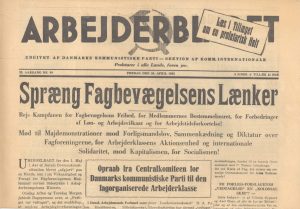
Se også:
Arbejderforlaget 100 år. Af John Poulsen (Arbejderen.dk, 23. september 2021). “I 1921 blev tre mindre forlag slået sammen til Arbejderforlaget, og Thøger Thøgersen blev valgt til forlagsleder. Den 23. september 1921 blev der holdt åbningsfest for det nyoprettede forlag i Haveselskabets lokale”
Se også på Socialistisk Bibliotek:
- Tidslinjen: 5. maj 1945, om DKPs dagblad Land og Folk.
22. maj – 12. juli 1921
Kommunistisk Internationales (Komintern) 3. kongres, vedtager enhedsfrontlinjen. Kongressens hovedbudskab var fra “kampen om magten” til “kampen om masserne” gennem enhedsfrontspolitik.
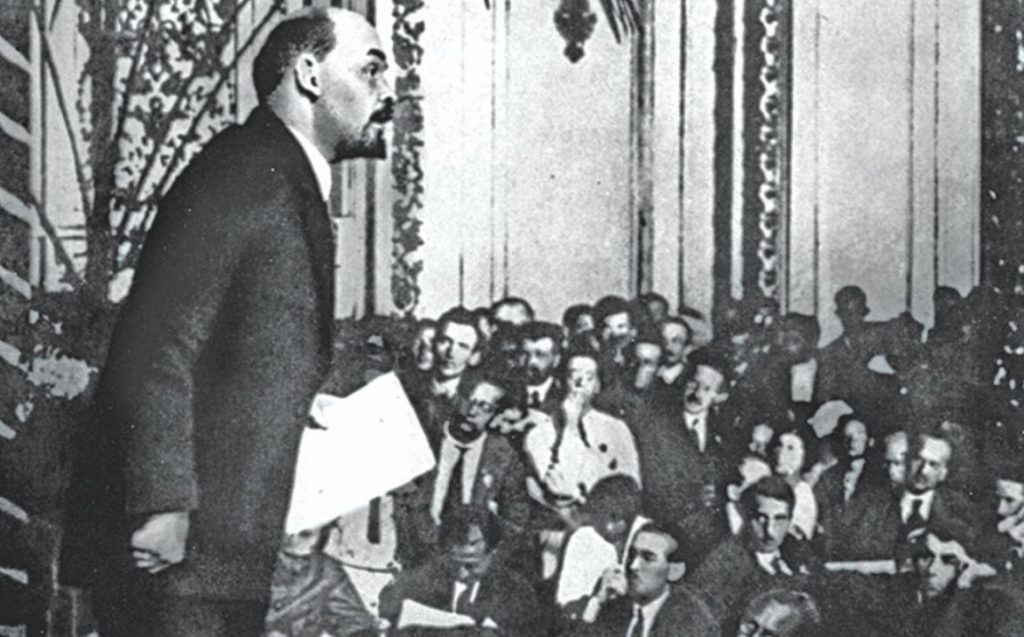
Se:
- Komintern: Første periode (1919-1922) (Leksikon.org)
Sites:
- Tema: Enhedsfront (Socialistisk Arbejderavis)
- V.I. Lenin: Tale til forsvar af Kommunistisk Internationales taktik (1. juli 1921) (Marxisme online)
- Leon Trotskij: Om enhetsfronten (Marxisme Online)
- The Communist International 1919–1943 (Marxists Internet Archive). Scroll ned.
- Speeches at the Third Congress of the Communist International, Moscow, June 22-July 12, 1921 (Marxists Internet Archive). Special section with newly translated and re-translations of speeches and reports at the 3rd Congress. Translation team organized by John Riddell.
- Speeches, Reports & Resolutions, Third Congres of the Communist International. Translated by John Riddell with others (Marxists Internet Archive)
- Moscow (Marxists Internet Archive). The English language daily publication reporting on the 3rd Congress. 42 issues, from May 25 (almost a month before the Congress started) past the end of the Congress on July 12.
First formulations of the United Front: Seven Comintern texts from 1921-23. Part 1-3 (John Riddell: Marxist Essays and Commentary, August 2, 2020). “These texts were addressed to Communist movements in Europe and the United States that coexisted with mass reformist-led Social Democratic parties and trade unions.”
Articles:
The Comintern and the United Front. By Darryl Horan (Irish Marxist Review, Vol.10, No.31, 2021). “The united front tactic was developed by German communists but only fully embraced by the endorsement of the Communist International in 1921 and 1922.”
Party organization in Lenin’s Comintern. Part 1: Defining Democratic Centralism + Part 2: How Democratic Centralism was applied. By John Riddell (Marxist Essays and Commentary, November 8-10, 2020). “This article will examine how this principle was expressed in the internal functioning of the Comintern’s national parties and also in their relationship to the Comintern’s leadership, the Executive Committee of the Communist International (ECCI).”
The Comintern’s great turn of 1920-21, Part 1: From the Second World Congress to the March Action + Part 2: The Third World Congress and its outcome. By John Riddell (Marxist Essays and Commentary, September 8, 2020). Introduction in To the Masses: Proceedings of the Third Congress of the Communist International, 1921 (Haymarket Books, 2016, p.1-46). På svensk: Kominterns viktigavändning 1920-1921 (pdf) (Marxistarkiv.se, 23. november 2020).
The United Front: adoption and application. By John Riddell (Marxist Essays and Commentary, July 1, 2020). Review of The Communist Movement at a Crossroads: Plenums of the Communist International’s Executive Committee, 1922–1923. Edited by Mike Taber and translated by John Riddell (Brill, 2018/Haymarket Books, 2019, 796 p.). “The central theme of this book is how the Comintern elaborated its united-front policy, a topic with rich relevance to us today.”
New Comintern Volume presents debates on United Front, Fascism. By John Riddell (Marxist Essays and Commentary, June 28, 2018) + The Comintern debates the United Front: Excerpts from the original leadership debate, 1922 (Marxist Essays and Commentary, May 5, 2019). With introduction by Mike Taber.
Newly published speeches by Lenin, Trotsky, and Béla Kun (Marxist Essays and Commentary, February 6, 2018). “The three speeches posted here constituted a turning point in efforts at the Communist International’s Third Congress, held in 1921, to reorient the movement away from adventurist leftism and toward the mass movements of working people.”
A workers’ International at a turning point. By John Riddell (International Socialist Review, Issue 99, Winter 2015-16). “Introducing excerpts from the Communist International’s Third Congress.”
Navigating unchartered waters (Weekly Worker, Issue 1085, 3 December 2015). “Ian Birchall examines the deliberations of Comintern’s Third Congress in the aftermath of the 1921 March action.”
Ian Birchall on John Riddell’s ‘To the masses’: Essential resource on communism’s early years (Links: International Journal of Socialist Renewal, April 12, 2015). Review of To The Masses: Proceedings of the Third Congress of the Communist International, 1921. Edited by John Riddell (Brill, 2015/Haymarket Books, 2016, 1299 p.). See more reviews:
- Comintern Congress revisited. By Ted McTaggart (Against the Current, Issue 180, January-February 2016).
- ‘To the Masses’ is ‘a triumphant climax’ to an ‘epic scholarly venture’. By Lars Lih (Marxist Essay and Commentary, March 14, 2016).
- Majorities, minorities, and revolutionary tactics. By Jennifer Roesch (International Socialist Review, Issue 101, Summer 2016).
- Debating the world revolution. By John Rose (International Socialism, Issue 153, Winter 2017).
- To the Masses. By Chris Bambery (Counterfire, February 2, 2017).
- ‘Heated debate and tumult’: The Comintern’s 1921 congress. By Umair Muhammad (Science and Society, Vol.81, No.3, July 2017, p.452-54; online at Marxist Essays and Commentary, December 26, 2017).
Profile of a Communist women’s movement. Introduced by Mike Taber and John Riddell (International Socialist Review, Issue 101, Summer 2016). “Excerpts from the Communist International’s Third Congress [by Clara Zetkin and Alexandra Kollontai].” See also Daria Dyakonova: The dawn of our liberation: The early days of the International Communist Women’s Movement (Marxists Essays and Commentary, September 13, 2018).
Lenin the unifier: The Comintern compromise of 1921. By John Riddell (Marxist Essays and Commentary, May 5, 2015). “The record speaks powerfully regarding Lenin’s role as a defender of principled revolutionary unity.”
German workers and the birth of the united front. By John Riddell (International Socialist Review, Issue 79, September-October 2011). “The policy of the united front is among the most effective tools for working-class action inherited from the era of V. I. Lenin and the Russian Revolution. As originally formulated by the Executive Committee of the Communist International (Comintern) in December 1921 …”
The origins of the united front policy. By John Riddell (International Socialism, Issue 130, Spring 2011, p.130-140). “The policy of the united front is among the most effective tools for working class action inherited from the era of VI Lenin and the Russian revolution.”
The united front: ground for common work (Socialist Worker, Issue 2076, 10 November 2007). “John Riddell, the pre-eminent historian of the International, looks at how revolutionaries can make alliances with trade unions and reformist organisations.”
The Ebb. Chapter 3 in Duncan Hallas: The Comintern (Bookmarks, 1985, p.54-82; online at Marxists Internet Archive). “What should a revolutionary party do in a non-revolutionary situation? In 1919 this was not an issue. By 1921 it was central.”
Meetings in the Kremlin in Moscow 1921 (Libcom, January 4, 2006). “An interview conducted in 1964 with former KAPD (Communist Workers Party of Germany) member Bernhard Reichenbach about the 1921 Communist International Congress in Moscow, after which the KAPD withdrew from the Comintern.”
La Internacional Comunista (tercer congreso), 1921 (YouTube.com, 3:26 min.)
Lenin’s Comintern revisited: Index (John Riddell: Marxist Essays and Commentaries, December 31, 2017). Articles by John Riddell, 2007-2018.
Se også på Socialistisk Bibliotek:
1. juni 1921
Omfattende angreb mod sorte amerikanere og forretninger og virksomheder ejet af sorte i kvarteret Greenwood i byen Tulsa, Oklahoma.
Links:
- Raceoptøjerne i Tulsa 1921 (Wikipedia.dk)
- Tulsa race massacre (Wikipedia.org)
- 1921Tulsa Race Masacre (Tulsa Historical Society and Museum)
107-årig husker USA’s glemte massakre i Tulsa: Jeg kan stadig lugte røgen og se ligene på gaden. Af Martin Burcharth (Information, 1. juni 202, side 8-9). Under betalingsmur, men med foto af ‘det velstående sorte kvarter Greenwood efter angrebet’.
A century since the Tulsa race massacre of 1921. By Dan La Botz (New Politics, June 11, 2021). “One hundred years ago, a white mob attacked the black neighborhood of Greenwood in Tulsa, Oklahoma and in two days killed hundreds of people, burned to the ground every building, and left ten thousand homeless.”
Racist war in the USA, 1921: the Tulsa Massacre. By Sacha Ismail (Solidarity & Workers’ Liberty, Issue 595, 2 June 2021). “A hundred years ago — in the days from 31 May 1921 — the city was the site of a bloody orgy of murder and de–struction against its black population, backed up by the power of state and local government.” See Part 2: The first time planes bombed a US city: Tulsa, 1921 (Ibid., Issue 596, 9 June 2021) + Part 3: Tulsa: the legacy of the massacre (Ibid., Issue 598, 23 June 2021).
The centenary of the Tulsa, Oklahoma race massacre. By Niles Niemuth (World Socialist Web Site, 1 June 2021). “This week marks the centenary of the Tulsa, Oklahoma race massacre, one of the deadliest and most destructive antiblack pogroms in the history of the United States.”
United States: The racist terror of Tulsa 1921. By John Peterson (In Defence of Marxism, 1 June 2021). “Despite a brave attempt by black residents of Tulsa to fight the pogromists, an estimated 300 black people were murdered in those events. The true history of these events has been airbrushed to this day. They represent the horrific fruit of centuries of divide and rule by the American ruling class.”
Tulsa’s long history of racism (SocialistWorker.org, April 10, 2012). “Lee Sustar puts last weekend’s racist killing spree in Oklahoma’s second-largest city in the context of Tulsa’s long history of racist violence.
11. juni 1921
Tegneren og grafikeren Ib Spang Olsen fødes på Østerbro. (dør 15. januar 2012, se denne).
Se:
- Ib Spang Olsen (Denstoredanske.dk)
Se også på Socialistisk Bibliotek:
- Ib Spang Olsen (Socialister på Assistens Kirkegård; Andre bemærkelsesværdige)
1. (?) juli 1921
12-13 personer mødes i Shanghai, i den tidligere franske handelsmissions bygning, og afholder Kinas Kommunistiske Partis første kongres. Medlemstallet anslås til under 60 over hele Kina.
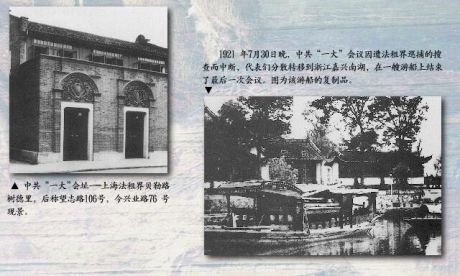
Se:
- History of the Communist Party of China (Wikipedia.org)
Kinas kommunist parti 100. Af Torkil Lauesen (Konfront, 12. september 2021). “I KKP’s hundrede års historie er der begået mange fejl, men når regnebrættet gøres op er dets resultater imponerende.”
Kinas Kommunistiske Parti fejrer sine 100 år med et historisk glansbillede (Autonom Infoservice, 2. juli 2021). “Partiets jubilæum fejres med en gigantisk iscenesat festuge, der udstråler succes og magt. Her er ingen plads til de mørke kapitler i partiets historie og ingen kritiske blikke på partiet af i dag.”
The real origins of the Chinese Communist Party. By Paul Hampton (Solidarity & Workers’ Liberty, May 2023). “The early history of the Chinese Communist Party (CCP) is shrouded in myths. The Maoists have sought to elevate the role of Mao Zedong, at the expense of Chen Duxiu. They have also downgraded the importance of Russian and Japanese influences.”
One hundred years ago a very different Chinese Communist Party was born. By Thomas Harrison (New Politics, August 17, 2021). “The Chinese Communist Party, founded in 1921 by revolutionary socialists inspired by democratic Marxism and the 1917 Bolshevik Revolution, was essentially destroyed by Chiang Kai-shek in 1927-28.”
Old wine in new bottles?: The Chinese Communist Party (CCP) celebrates its centenary (Anti Capitalist Resistance, 14 July 2021). “Peter Wong writes on the CCP centenary and says it is plain silly to describe today’s China or CCP as ‘communist’ or ‘socialist’.”
På svensk: Kinas kommunistiska parti fyller 100 år (pdf) (Internationalen, nr.6/8, 2021; online på Marxistarkiv.se).
100 years of the Chinese Communist Party. By Steve Smith (Jacobin, July 1, 2021). “The Chinese Communist Party turns 100 as a party of power in one of the world’s most important states. It’s been a long road from the CCP’s early years as a band of revolutionary outlaws that narrowly escaped obliteration by its enemies.”
Founding of the Chinese Communist Party: heroism and tragedy. By Daniel Morley (In Defence of Marxism, 1 July 2021). “The party was founded as a healthy Bolshevik organisation. But within only a handful of years, these promising beginnings were distorted by heavy Stalinist interference from Moscow, which led to the defeat of the first Chinese Revolution in 1925-7. It is the founding of the party and this tragic revolution we examine here.”
100 years since the founding of the Chinese Communist Party. By Peter Symonds (World Socialist Web Site, 1 July 2021). “The world historical significance of the 1921 founding of the Chinese Communist Party stands in stark contrast to the hypocrisy and falsifications that characterise the official centenary celebrations.”
The origins and degeneration of the Chinese Communist Party. By Tom Bramble, Mick Armstrong and April Holcombe (Red Flag, 30 June 2021). “The Chinese Communist Party is celebrating its centenary. From its origins among a handful of activists in an economically underdeveloped country occupied by more advanced capitalist powers, to the hegemonic bureaucracy ruling what is now one of the most powerful imperialist states in world history, the CCP has undergone several transformations.”
Young Pioneers: May Fourth Manifesto (New Left Review, Issue 116/117, March-June 2019). “A resounding call for labour rights and democracy on the centenary of the youth uprising of May 1919, swiftly removed from the internet.”
One hundred years since the May 4 movement in China. Part 1-2. By Peter Symonds (World Socialist Web Site, 4-6 May 2019). “The Chinese Communist Party (CCP) was founded in July 1921, little more than two years after the first Beijing protest. Many of the founding members were youth who had been radicalised by the May 4 movement.”
90 years of the Chinese Communist Party. By Dan Morley (In Defence of Marxism 1 July 2011). “On the ninetieth anniversary of the founding of the Chinese Communist Party we published a series of articles that trace the origins and subsequent development of this party, which has played a key role in world history. Dan Morley outlines the conditions in China that led to the foundation of the party as part of the Communist International.
Revolutionärerna i Kinas städer (pdf). Av Gregor Benton (Marxistarkiv.se).
Engelsk original: China’s Urban Revolutionaries: Explorations in the History of Chinese Trotskyism, 1921-1952 (Humanities Press, 1996, p.1-123). Se også Gregor Benton: Explorations in the history of Chinese Trotskyism (pdf) (IIRE Working Papers, Issue 26, 1992, 50 p.) + Gregor Benton (ed.): Prophets Unarmed: Chinese Trotskyists in Revolution, War, Jail, and the Return from Limbo (Brill, 2015/Haymarket Books, 2017, 1269 p.)
The awakening of the Chinese workers’ movement (Revolutionary History, Vol.2, No.4, Spring 1990, p.5-6). “The pieces illustrate the high level of consciousness already shown by the Chinese working class …”
The Origins of Chinese Communism. By Al Richardson (Revolutionary History, Vol.2, No.4, Spring 1990, p.48-49; online at Marxists Internet Archive). Review of Arif Dirlik’s book (Oxford University Press, 1989). “This is a work of most intensive scholar ship, one of the few to provide fresh in formation and insight into the origin and peculiarities of Chinese Communism.”
The workers’ revolution. Chapter 1 in Nigel Harris: The Mandate of Heaven: Marx and Mao in Modern China (Quartet Books Limited, 1978, p.3-15; online at Marxists Internet Archive). “The party, though ambitious, was but a small group of intellectuals who lacked support among China’s workers … In 1921, the party claimed fifty-seven members; and 432 in 1923.
Origins of the Chinese Revolution, 1915-1949. By Lucien Bianco (Stanford University Press, 1971). Extracts from chapter 1-3 at Google Books.
The new awakening. Chapter 3 in Harold R. Isaacs: The Tragedy of the Chinese Revolution (London, 1938; online at Marxists Internet Archive).
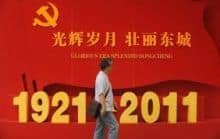
Leksika:
- May Fourth Movement (Wikipedia.org)
- Chen Duxiu (Wikipedia.org)
- China / Chinese Trotskyism (Marxists Internet Archive)
Se også på Socialistisk Bibliotek:
- Linkboxen Folkerepublikken Kina, 1949-
- Linkboxen China and Capitalism
31. august 1921
Den britiske marxistiske kulturkritiker og forfatter Raymond Williams fødes i Wales (dør 26. januar 1988 in Saffron Walden, nær Cambridge).
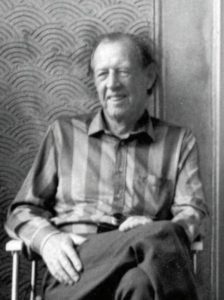
Se:
- Raymond Williams (Denstoredanske). Kort leksikal.
- Raymond Williams (Wikipedia.org). Incl. works.
- The Raymond Williams Society (site). See here: “Reflections on Raymond Williams” [2018], Part 1 by Patrick Parrinder + Part 2 by Terry Eagleton.
Raymond Williams exposed the ruthless class oppression behind our literary traditions. By Daniel Hartley (Jacobin, September 20, 2023). “Fifty years ago, socialist writer Raymond Williams’s The Country and the City challenged preconceptions about the gap between rural and urban life. His book exposed the realities of class exploitation — and imagined the abolition of the country-city divide.”
The Marxism of Raymond Williams. By Bashir Abu-Manneh (Catalyst Review, November 24, 2022). Review of Raymond Williams, Culture and Politics: Class, Writing, Socialism, ed. by Phil O’Brien (Verso, 2022, 240 p.). “Raymond Williams was a Marxist whose politics were deeply anchored in radical working-class and internationalist traditions. Recent postcolonial critics have accused him of ignoring the realities of empire. Examining his body of work shows this is wrong.”
Raymond Williams was a socialist visionary. By Peter Hill (Jacobin, August 31, 2021). “Raymond Williams would not have claimed to have found all the answers. But we should remember him as one of the most thoughtful socialist writers of the 20th century.”
Raymond Williams: Socialism, culture, revolution (Verso, Blog, 24 August 2018). “Ben Harker maps Williams’s developing positions on the relationship between culture, consciousness, class power, and socialist strategy.”
Raymond Williams: thirty years on. By Matthew (Solidarity & Workers’ Liberty, 31 January 2018). “In the 60s and 70s Williams’ star shone brightly in the intellectual firmament of the left. It has faded somewhat since. Unjustly so in my opinion …”
Reflections on Raymond Williams (Verso, Blog, 29 January 2018). “Terry Eagleton, Elinor Taylor, Jacob Soule, Patrick Parrinder, and others on the life and work of Raymond Williams.”
Culture and Society, then and now. By Francis Mulhern (New Left Review, Issue 55, January-February 2009). “The idea of culture in Raymond Williams’s classic work, and discrepant readings of it, fifty years on. Gestation amid CP debates on the English tradition, hidden affinities with the Frankfurt School, and counterposition to the verities of today’s liberal multiculturalism.”
Raymond Williams, and why culture matters. By Terry Eagleton (Against the Current, No.137, November/December 2008). “This year sees the 20th anniversary of the death of Raymond Williams, one of the towering socialist thinkers of the 20th century.”
Upwards and onwards. By Stefan Collini (London Review of Books, Vol.30, No.15, 31 July 2008). Review of Dai Smith, Raymond Williams: A Warrior’s Tale (Parthian, 2008, 514 p.). “One immediate disappointment is that Smith’s is not the full biography so eagerly anticipated: he covers only the first forty years of Williams’s life, stopping in 1961 … Nonetheless, what Smith has done he has done well.”
Raymond Williams and the moral project of the new left. By Terry Murphy (Against the Current, No.71, November/December 1997). Review of Dennis L. Dworkin and Leslie C. Roman (eds.), Views Beyond the Border Country: Raymond Williams and Cultural Politics (Routledge, 1993)
Romanticism in the English social sciences: E.P. Thompson & Raymond Williams. By Michael Löwy and Robert Sayre (Against the Current, No.61, March-April 1996). “Williams undeniably evolved over the course of his career, but he never repudiated the Romantic underpinnings of his thought.”
Raymond Williams: revitalising the left? By Chris Nineham (International Socialism, Issue 71, June 1996, p.117-129). Review of F. Inglis, Raymond Williams (Routledge, 1995). “Raymond Williams deserves a better memorial than this. Author Fred Inglis claims to be a devout fan but his respectful tone only half hides his sneers.”
Raymond Williams: centrist tragedy? By Ian Birchall (International Socialism, Issue 39, Summer 1988, p.139-161; online at Grim and Dim). “It is a commonplace to note the preoccupation with ‘borders’ in Williams’ work. Most of his work was produced on the uneasy borderline between reform and revolution. And his greatest strength was his ability to constantly cross the frontier between theory and practice.”
The life of Raymond Williams. By Stuart Hall (The New Statesman, 5 February 1988; online at Internet Archive). “In this article, published at the time of his death, Stuart Hall, much influenced by Williams in his own work, assesses his importance.”
Raymond Williams, culture and Marxism. By Colin Sparks (International Socialism, Issue 9, Summer 1980, p.131–144). “In the case of Williams, I want to argue, some of the questions he has asked have been ones upon which our own answers have been very shaky.”
Raymond Williams comments on the keyword ‘nature’ at the ‘Linguistics of Writing’ conference, University of Strathclyde, Glasgow, UK, in 1986.
Raymond Williams and Keywords. By Stephen Heath (Keywords Project; University of Pittsburg). Incl. video: Raymond Williams draws attention to the complexity of a keyword (‘nature’) … (4:58 min.).
Litteratur på dansk:
- De loyale. Af Raymond Williams (Klim, 1986, 355 sider)
- Orwell. Af Raymond Williams (Tiderne Skifter, 1984, 116 sider)
- Massemedierne. Af Raymond Williams (Fremad, 1963, 197 sider)
10. september 1921
Første nummer af norske tidsskrift Mot Dag udkom (sidste nr. 20.6.1936). Udkom ikke i 1929 og 1930, så der udkom i alt 14 årgange.
Fra april 1933 udgav gruppen Arbeidernes Leksikon (1931-1936). Ved opløsning i 1936 gik de fleste over i Tiden Norsk Forlag.
Se:
- Tidsskriftet Mot Dag (1921-36) (Marxistisk Internet Archive; Norsk). Tekster fra tidsskriftet.
- Mot Dag (Leksikon.org)
- Mot Dag (Wikipedia.no)
The Mot Dag Association: ‘Leftist academics preaching radical ideas’. By Geir Bentzen (Socialist History, Issue 21, 2002; online at Internet Archive WayBackMachine).
Se også på Socialistisk Bibliotek:
- Tidslinjen 11. marts 1931 om udgivelsen af Arbeidernes Leksikon.
















